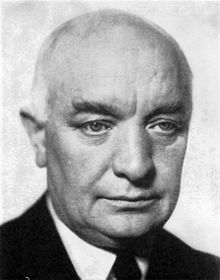Folkhemmet
Folkhemmet ( Swedish for "people's home") was an important political metaphor for the Swedish Social Democrats in the 1930s and 1940s, which stood for the welfare state that was strived for. The term is rarely used today - except in relation to its history. Instead one speaks of the “ Swedish welfare state ”.
origin
The term “Volksheim” as a metaphor for a political vision first appeared in nationalist and right-wing conservative circles. The political scientist and politician Rudolf Kjellén developed an authoritarian and mystical concept of the state in his work Der Staat als Lebensform (1916), which defined the state as an organism, and also spoke of a future people's home. Even Manfred Björkquist , the leader of a major revival movements within the Church of Sweden , Ungkyrkorörelsen , and peasant leaders and adopted the term.
Social democratic metaphor
In 1928, the leader of the Social Democratic Workers' Party, Per Albin Hansson, took up the term “people's home” in a debate in the (then) second chamber of the Reichstag to describe the goals of social democratic policy. In his (in Sweden) famous speech he said among other things:
“The foundation of the home is togetherness and understanding. In the good home there are no privileged or disadvantaged people, no cuddly children and no stepchildren. There no one looks down on the other, there no one tries to gain advantages at the expense of the other, and the strong do not oppress the weak and plunder them. In the good home there is equality , care , cooperation and helpfulness. Applied to the people's and fellow citizens' home, this would mean the dismantling of all social and economic barriers that the citizens now divide into the privileged and the disadvantaged, the rulers and the dependent, the rich and the poor, the wealthy and the impoverished, the plunderers and the plundered. "
The 1932 elections brought the Social Democrats to government. The new government successfully fought the consequences of the global economic crisis of 1929 with employment programs and structural programs. In 1938, the Saltsjöbaden Agreement laid the foundation for the long-term Swedish social partnership: Sweden began building its “people's home” - the welfare state that has shaped the country to this day .
The term “Volksheim” quickly developed into one of the most important political metaphors for social democratic politics and vision for the next two decades.
Talking about the people's home also meant turning away from Marxism and at the same time embracing national feelings - the people's home was originally a nationalist term. There were also such cross-connections in many other countries, for example in Germany the National Socialists captured and instrumentalized the old term “ Volksgemeinschaft ”.
Although leading Social Democrats often used the term in their political speeches, the idea was never formally incorporated into the party program by the Swedish Volksheim . The Volksheim was more of a metaphor for an ideology than an expression of concrete political objectives. Today, the term is mainly associated with Per Albin Hansson and his time as party chairman (1925 to 1946). His successor, Tage Erlander , spoke more of the “strong society” when he talked about the objectives of social democracy; later the term was replaced by the word welfare state.
A specific project that was supposed to realize the utopia of modern living together like in a people's home was the collective house that opened in Stockholm in 1935 .
See also
literature
- Henrik Berggren, Lars Trägerårdh: Är svensken Bäumenka? Gemenskap och oberoende i det moderna Sverige . Norstedt, Stockholm 2006, ISBN 91-1-301561-3 .
- Norbert Götz: Unequal siblings. The construction of the National Socialist People's Community and the Swedish People's Home . Nomos-Verl.-Gesellschaft, Baden-Baden 2001, ISBN 3-7890-7410-1 , ( The cultural construction of communities in the modernization process 4), (At the same time: Berlin, Humboldt University, dissertation, 2000).
- Valeska Henze: The Swedish people's home. On the structure and function of a political order model, Florenz / Berlin 1999. ( online )
Individual evidence
- ↑ Translated by Folkhemmet, medborgarhemmet
